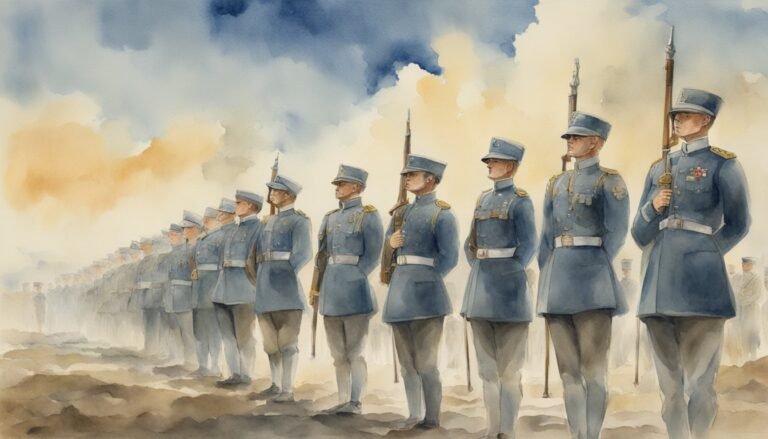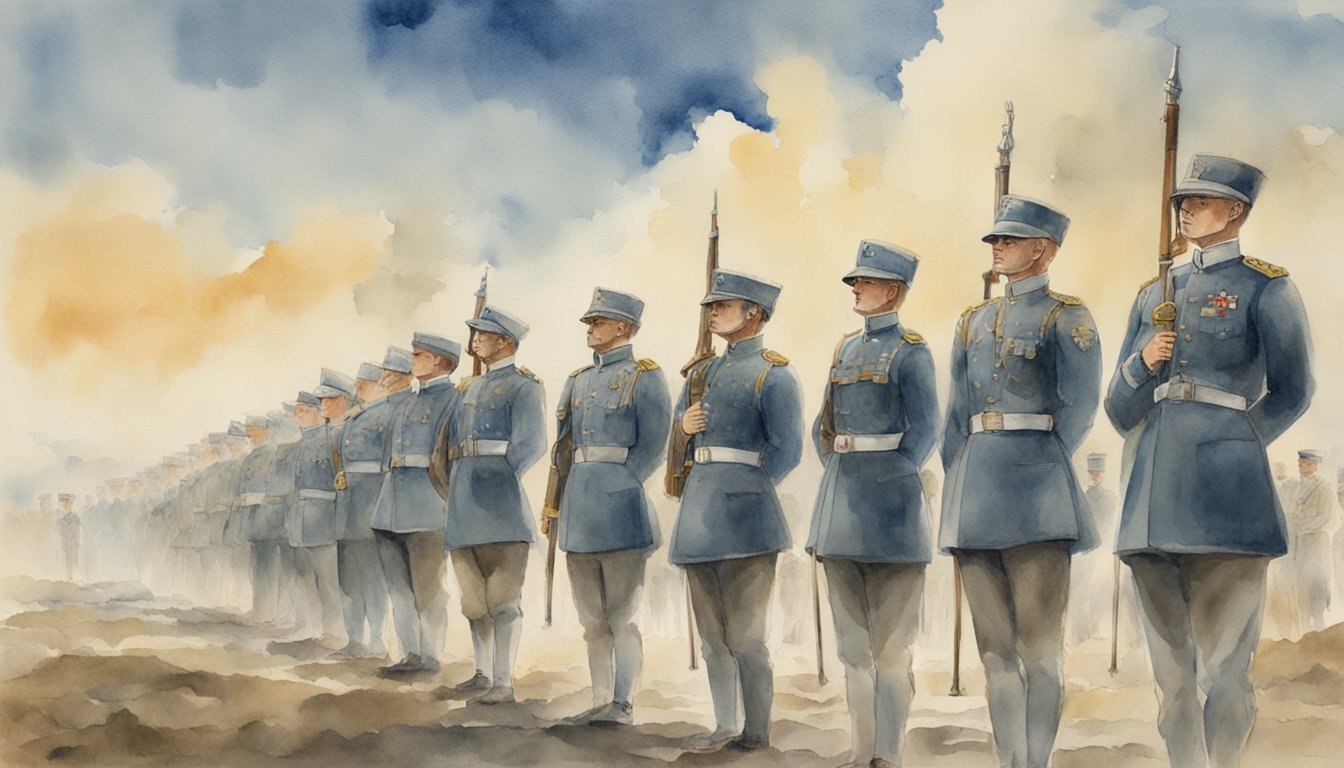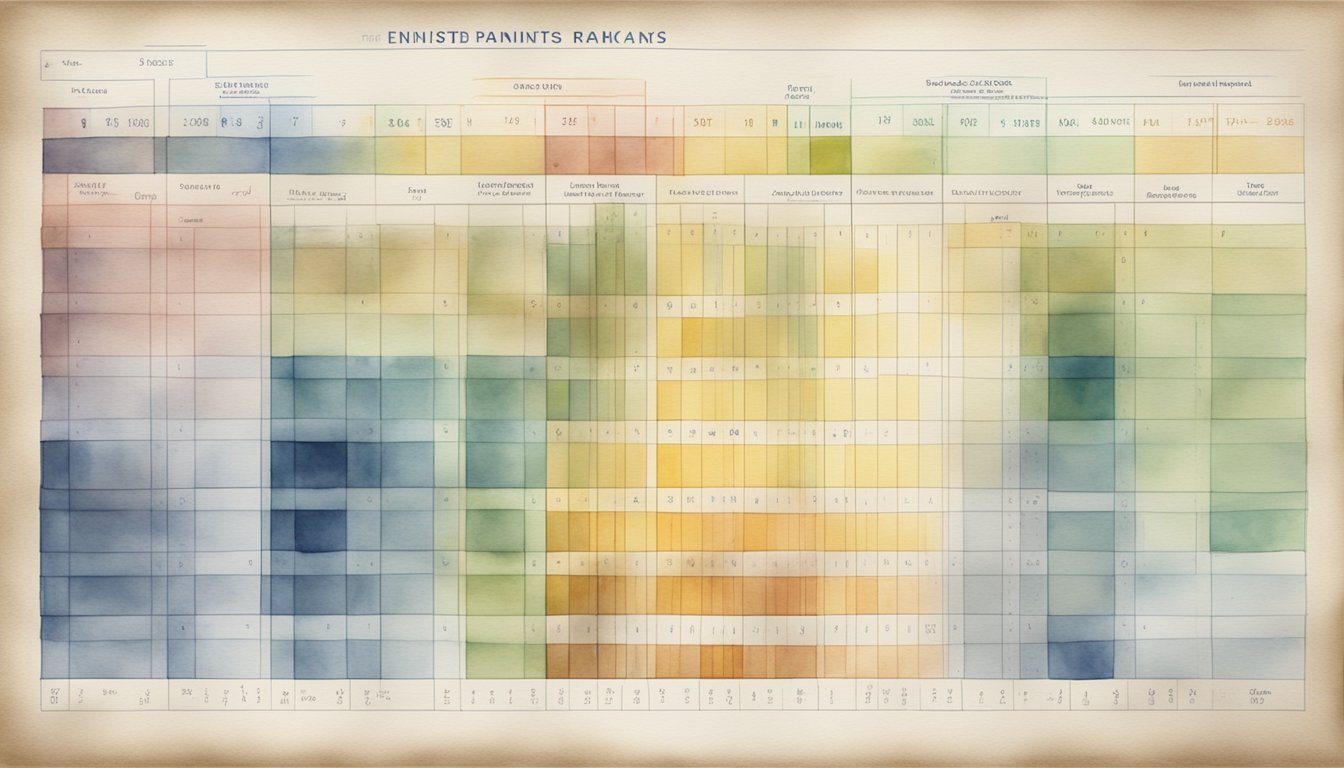Army Enlisted Ranks: Your Quick Guide to Moving Up

Understanding the ranks in the U.S. Army can seem complicated, but it’s essential to grasp how each rank reflects a soldier’s expertise, responsibility, and authority.
Enlisted ranks start from Private and move up to Sergeant Major of the Army, each with distinct roles and duties. Knowing these ranks can help you understand the career progression and structure within the military, whether you’re considering enlisting or just curious about how the Army operates.

Enlisted soldiers are the backbone of the Army, and their ranks are divided into junior enlisted ranks and non-commissioned officers (NCOs).
Private, Private Second Class, and Specialist are some of the junior enlisted ranks, where soldiers begin their military journey.
As they gain experience, they can move up to NCO ranks like Sergeant and Staff Sergeant, which come with greater responsibilities and leadership roles.
The pinnacle of enlisted ranks is the Sergeant Major of the Army, a position held by the most experienced and capable soldiers.
Throughout your enlisted career, you’ll find opportunities for advancement, specialization, and increasing benefits.
Learning about these ranks offers a clearer picture of how the Army supports and rewards its dedicated soldiers.
Key Takeaways
- Key enlisted ranks range from Private to Sergeant Major of the Army.
- Enlisted soldiers start in junior ranks and can advance to senior NCO roles.
- Each rank comes with specific duties, benefits, and career opportunities.
Understanding the Enlisted Rank Structure
The enlisted rank structure in the U.S. Army is key to understanding how authority, responsibility, and career progression work.
These ranks range from Private to Sergeant Major, each with specific roles and pay grades.
Basics of Enlisted Ranks
Enlisted ranks start at Private (E-1) and progress up to Sergeant Major of the Army (E-9).
You begin your journey as a Private, where you learn basic skills and start your military career.
As you gain experience and complete training, you move up through ranks like Private First Class (E-3) and Specialist (E-4), taking on more responsibilities along the way.
Non-Commissioned Officers (NCOs) start at Corporal (E-4) or Sergeant (E-5).
NCOs are crucial leaders and trainers for the lower ranks.
They ensure discipline and readiness among soldiers.
Each rank holds its own weight in the hierarchy, signifying different levels of expertise and leadership.
Enlisted Ranks and Pay Grades
The Army enlisted ranks each correspond to a specific pay grade.
For instance, a Private (E-1) is in the lowest pay grade, while a Sergeant Major (E-9) earns the highest pay among enlisted soldiers.
Here’s a simplified breakdown:
- E-1: Private
- E-2: Private Second Class
- E-3: Private First Class
- E-4: Specialist / Corporal
- E-5: Sergeant
- E-6: Staff Sergeant
- E-7: Sergeant First Class
- E-8: Master Sergeant / First Sergeant
- E-9: Sergeant Major
Higher ranks and pay grades mean more responsibilities, such as leading larger groups of soldiers and handling complex missions.
Comparing Enlisted to Officer Ranks
Enlisted ranks differ significantly from officer ranks.
Officers hold positions of authority and leadership, starting at Second Lieutenant and moving up to General.
They are typically responsible for planning missions, making strategic decisions, and overseeing enlisted soldiers.
In contrast, enlisted soldiers, especially NCOs, focus on executing plans and managing day-to-day operations.
NCOs serve as a bridge between the enlisted ranks and the officers.
They ensure that the orders from the officers are carried out effectively by the enlisted soldiers.
Understanding these distinctions helps you grasp the roles each person plays in the Army’s structure, ensuring missions are accomplished smoothly and efficiently.
Starting Out: The Junior Enlisted Ranks
Junior enlisted ranks in the U.S. Army lay the foundation for your military career.
These ranks include Private (E-1), Private Second Class (E-2), and Private First Class (E-3), plus Specialist and Corporal (both E-4).
Private Ranks: E-1 to E-3
Private (E-1) is where you start right after enlistment.
This rank focuses on basic training and understanding military life.
Private Second Class (PV2), or E-2, usually comes about six months after starting.
You now get more duties, mostly basic tasks like helping out with equipment and simple field tasks.
Your pay increases slightly, and you begin to get a bit more respect from your peers.
Private First Class (PFC), or E-3, is a step up.
At this stage, you have probably gained about a year of experience.
Your duties expand, and you might start to see some action in combat settings.
As a PFC, you contribute more significantly to your unit, whether in infantry, artillery, or armor.
The Role of Specialists and Corporals
Once you reach Specialist (SPC), you continue at the E-4 pay grade but focus considerably on your specific job within the Army.
Specialists might specialize in areas like logistics or mechanics, and they often become highly skilled in their tasks.
Despite similar pay, an SPC doesn’t have the same supervisory duties as a corporal.
Corporal (CPL), also at E-4, bridges the gap between junior enlisted ranks and noncommissioned officers.
As a corporal, you have the responsibility to oversee small teams and ensure tasks are completed efficiently.
This rank hones your leadership skills, preparing you for higher responsibilities.
Both specialists and corporals play key roles in maintaining the daily operations and combat readiness of the Army, setting the stage for further advancement and leadership opportunities.
Non-Commissioned Officers: Backbone of the Army
Non-Commissioned Officers (NCOs) play a crucial role in the Army by leading soldiers and ensuring tasks are completed efficiently.
They are often seen as the link between the enlisted ranks and the officer corps, carrying out vital leadership and training duties.
Becoming an NCO: Sergeant and Staff Sergeant
To become a sergeant (E-5) or staff sergeant (E-6), you must first demonstrate leadership potential and complete specific training.
As a sergeant, you will take on more responsibilities, such as supervising a small team, conducting training exercises, and ensuring soldiers’ welfare.
Promotion to staff sergeant involves even greater responsibility.
You’ll manage more significant units, mentor junior NCOs, and handle administrative tasks.
Your leadership skills will be tested as you balance the welfare of your soldiers with mission objectives.
These ranks are vital in maintaining discipline and readiness within the Army.
NCOs are often referred to as the backbone of the Army because of their essential role in daily operations.
They are the first line of leadership and play a key role in developing the next generation of soldiers.
Senior Non-Commissioned Officers
Once you reach the rank of sergeant first class (E-7), you are considered a senior non-commissioned officer.
In this position, you will handle more complex tasks and provide guidance to both soldiers and junior NCOs.
Your leadership influences the entire unit’s performance.
As a first sergeant (E-8), your responsibilities expand further.
You’ll be involved in the administration and management of a company, ensuring that all soldiers are ready for deployment.
Your experience and leadership skills are critical in maintaining unit cohesion and effectiveness.
At the rank of master sergeant or sergeant major (E-9), you will serve as the principal advisor to officers on all enlisted matters.
Your vast experience will be crucial in planning and executing missions.
NCOs at this level are essential in shaping Army policies and mentoring future leaders.
The Pinnacle of Enlisted Ranks
Reaching the highest levels of enlisted ranks in the Army requires exceptional leadership and expertise.
These roles are held by the most senior non-commissioned officers, who guide and mentor both enlisted soldiers and junior officers.
Command Sergeants Major and SMA
As a Command Sergeant Major (CSM), you hold a vital leadership position within battalions, brigades, and divisions.
Your responsibilities include advising commanders and ensuring the welfare of soldiers.
You lead by example and play a key role in maintaining discipline and readiness.
The Sergeant Major of the Army (SMA) is a unique role.
As the top enlisted advisor to the Army Chief of Staff, the SMA focuses on soldier issues, training, and quality of life improvements.
Holding this position is a testament to a soldier’s career-long dedication and expertise.
These roles are pivotal in shaping the Army’s future.
Without the leadership of senior NCOs like Command Sergeants Major and the Sergeant Major of the Army, the Army’s effectiveness and morale would be significantly impacted.
Career Progression and Promotions
As you advance in your Army career, you’ll encounter various stages of growth and development.
This process heavily relies on your time in service, professional development, and meeting specific promotion criteria.
Time in Service and Professional Development
Your time in service plays a crucial role in your progression.
As you gain more time in the Army, you build expertise in your Military Occupational Specialty (MOS).
During this time, you’ll also be required to participate in professional development courses.
From basic training to specialized courses, these training programs aim to enhance your skills and leadership abilities.
For example, as you move up the ranks to become a noncommissioned officer or even a warrant officer, professional development becomes even more important.
Each rank has specific courses designed to prepare you for the responsibilities ahead.
These courses may include leadership training, advanced tactical skills, and MOS-specific educational modules.
Promotion Criteria and Advanced Training
Promotions in the Army depend on several key factors, with time in service being just one of them.
Other criteria include performance evaluations, completion of advanced training, and leadership potential.
Your performance evaluations are regular assessments that gauge your ability to execute tasks efficiently and effectively.
These evaluations are crucial for moving up the ranks.
In addition to evaluations, completing advanced training courses is also vital.
For instance, to advance from a junior enlisted rank to a noncommissioned officer, you must complete the Basic Leader Course (BLC).
As you aim for higher ranks, such as Senior Noncommissioned Officer, you’ll need to complete courses like the Advanced Leader Course (ALC) and the Senior Leader Course (SLC).
You can find more detailed information on the Army’s promotion timeline for enlisted officers.
These steps ensure that each soldier is well-prepared and qualified for their next role.
Branches and Specializations within the Army
In the Army, soldiers are assigned to various branches that focus on different areas of expertise.
These divisions ensure that every mission has the right skills and support for success.
Combat Arms: Infantry, Armor, and Field Artillery
Infantry is the backbone of the Army, responsible for ground combat.
As an infantry soldier, you specialize in close-quarters fighting, using small arms and engaging the enemy directly.
Your training focuses on physical endurance, tactical maneuvers, and weapons proficiency.
Armor units operate tanks and other armored vehicles.
These soldiers provide powerful support during combat operations, using heavy firepower to break through enemy defenses.
Armor specialists must be skilled in vehicle maintenance, navigation, and coordinated attacks.
Field Artillery is crucial for delivering long-range fire support.
Artillery units use cannons, rockets, and missile systems to target enemy positions from a distance.
Your role involves calculating firing solutions, coordinating with forward observers, and maintaining advanced artillery equipment.
Support and Service: Engineering, Intelligence, and More
Engineers in the Army handle a variety of tasks including constructing military infrastructure, clearing obstacles, and demolitions.
As an engineer, you might build bridges, fortifications, and roads, ensuring that troops can move safely and efficiently.
Military Intelligence provides critical information on enemy movements and capabilities.
Intelligence officers and analysts gather data through surveillance, reconnaissance, and cyber operations.
Your expertise helps command make informed decisions and anticipate threats.
Other support roles include logistics, medical services, and communications.
These functions ensure that soldiers have the supplies, care, and connectivity needed to maintain operational effectiveness.
Whether you’re transporting supplies, providing medical aid, or establishing secure communication lines, your role is vital to the overall mission success.
Dress and Field Insignia of Enlisted Ranks
In the Army, rank insignia are crucial for identifying the role and responsibility of soldiers.
Properly displaying these insignia on uniforms ensures that everyone recognizes the hierarchy and duties within the unit.
Understanding Rank Insignia
Each enlisted rank in the Army has a unique insignia.
These insignia are worn on uniforms, both dress and field, to signal rank and responsibility.
For instance, a corporal (E-4) and a sergeant (E-5) wear chevrons, but they differ slightly in design.
Specialist (E-4) insignia are different from NCO insignia, lacking chevrons.
Non-commissioned officers like sergeants and corporals bear additional symbols like rockers below their chevrons.
The position and size of these insignia vary slightly between dress and field uniforms to ensure they remain visible and recognizable in different conditions.
The Importance of Proper Insignia Display
Insignia must be displayed correctly on uniforms for clear rank identification.
On dress uniforms, insignia are often made of higher quality materials and can include lace and embroidery.
Field uniforms, however, use simpler, durable insignia to withstand rough conditions.
Proper display of insignia helps maintain military order and discipline.
It ensures that everyone knows who holds authority, which is vital during both training and combat situations.
Incorrect or missing insignia can cause confusion, impacting the efficiency and safety of operations.
Displaying insignia properly ensures respect for each rank and the responsibilities that come with it.
This respect is essential for unit cohesion and effective leadership within the Army.
Pay and Benefits for Enlisted Personnel

When you join the Army as enlisted personnel, your pay and benefits are based on a structured system.
You receive various allowances and bonuses in addition to your basic pay, which are designed to support you during your service.
Basic Pay Scale for Enlisted Ranks
Basic pay in the Army depends on your rank and years of service.
For example, a new recruit (E-1) starts with a basic pay of $2,017 per month.
As you gain experience and promotions, your pay increases.
For instance, an E-6 with over 10 years of service earns about $4,387.80 monthly.
This structured pay scale ensures you are compensated fairly based on your role and experience.
Access to this information helps you gauge possible income as you advance in rank.
Additional Benefits and Allowances
The Army provides more than just basic pay.
You get various allowances and benefits.
One key benefit is the housing allowance, which covers your living costs while on duty.
Health care is another significant benefit, offering comprehensive medical coverage for you and your family.
You also receive education benefits through programs like the GI Bill, which helps cover the cost of college or vocational training.
These extra benefits make military service financially rewarding and supportive of both personal and professional growth.
Joining the Army: Enlistment Process and Basic Training
In this section, you will learn about the requirements and steps for enlisting in the Army, and what to expect during Basic Combat Training.
Requirements and Steps for Enlisting
To join the U.S. Army as an enlisted soldier, you need to meet several criteria.
First, you should be between the ages of 17 and 35.
You must be a U.S. citizen or a lawful permanent resident with a valid Green Card.
Having at least a high school diploma or GED is essential.
You’ll also need to be physically and medically fit.
This means passing a physical examination and meeting specific health and fitness standards.
Additionally, you will take the Armed Services Vocational Aptitude Battery (ASVAB) test, which measures your suitability for military jobs.
The next step involves meeting with a recruiter to discuss your options and complete necessary paperwork.
You will then attend a Military Entrance Processing Station (MEPS) where you will undergo a medical exam, take the ASVAB, and complete other screening activities.
Once you meet all the requirements and pass the tests, you can enlist and take the Oath of Enlistment.
What to Expect at Basic Combat Training
Basic Combat Training (BCT) is the initial phase of training for new Army soldiers.
It’s designed to transform civilians into combat-ready soldiers.
BCT typically lasts about 10 weeks and is divided into three phases: Red, White, and Blue.
During the Red Phase, you’ll focus on learning Army values, customs, and physical fitness.
This period includes intense physical training, obstacle courses, and basic combat skills.
Expect long days filled with activities to build your endurance and discipline.
In the White Phase, you will learn advanced combat skills such as marksmanship and first aid.
This phase also includes more weapons training and field exercises to prepare you for real-life combat situations.
Finally, in the Blue Phase, you’ll put all your skills to the test in simulated combat scenarios.
You’ll participate in field training exercises and live-fire drills.
Completing BCT marks your transition from a civilian to an Army enlisted soldier, ready to move on to more specialized training in your chosen field.
Traditions and History of Enlisted Ranks
The U.S. Army’s enlisted ranks have a rich history, with traditions that have evolved over centuries, shaped by various wars and changes in military structure.
These ranks have deep historical significance and are marked by specific insignia.
From the Revolutionary War to Present
Enlisted ranks in the U.S. military date back to the Revolutionary War.
During this time, ranks were less formalized, and insignia were simple or non-existent.
It wasn’t until later conflicts, such as the Civil War, that a more defined system of rank insignia began to develop.
In the 20th century, significant changes occurred, especially during the world wars.
The First World War brought a need for more organized ranks due to the Army’s expansion.
Post-World War II, the Army further refined its rank structure, adding new insignia to reflect technological and structural changes within the military.
Historical Significance of Ranks and Insignia
Enlisted ranks have always played a crucial role in the structure and operation of the Army.
These ranks indicate a soldier’s experience, duties, and level of authority. Insignia serve as a visual representation of these ranks and have changed in style and material over the years.
Non-commissioned officers (NCOs) carry significant responsibilities and are often considered the backbone of the Army.
The insignia for NCOs, like sergeants and corporals, are distinct, highlighting their leadership roles.
Over time, the design and significance of these insignia have evolved to better represent the soldiers’ roles and the Army’s needs.
Traditions surrounding these ranks and insignia are deeply ingrained in military culture, reinforcing values like duty, respect, and loyalty among enlisted personnel.
Frequently Asked Questions
This section dives into the specifics of the enlisted ranks in the Army, covering hierarchy, pay grades, and the differences between various ranks.
What’s the lowdown on the hierarchy of Army ranks?
In the U.S. Army, the hierarchy starts with Junior Enlisted ranks like Private (E-1) and goes up to Senior Non-Commissioned Officers like Sergeant Major (E-9).
Each rank has specific duties and responsibilities.
The structure ensures a clear chain of command and leadership progression.
How does pay grade tie into the different ranks in the Army?
The pay grade is crucial as it determines your salary and benefits.
For instance, an E-1, which is a Private, starts at about $1,833.30 per month.
As you move up in rank, your pay grade and salary increase, reflecting your experience and responsibilities.
See more details here.
Can you break down the tiers within the enlisted ranks for me?
There are three tiers within the enlisted ranks.
The junior enlisted ranks range from E-1 to E-4, including roles like Private and Specialist.
The mid-level ranks are E-5 to E-7, covering Sergeants.
The senior NCOs span E-8 to E-9, like Master Sergeant and Sergeant Major.
What’s the scoop on the very top enlisted levels in the Army?
The top enlisted levels, E-8 and E-9, include ranks like First Sergeant, Master Sergeant, and Sergeant Major.
These roles carry significant leadership duties and responsibilities.
The highest enlisted rank is the Sergeant Major of the Army, who serves as an advisor to the Army Chief of Staff.
Learn more here.
Is there a quick rundown of Army officer vs enlisted ranks?
Enlisted ranks focus on technical skills and leadership within units, starting from E-1 to E-9.
Officers, starting at O-1 (Second Lieutenant), take on higher-level leadership and strategic roles.
While both paths are crucial, officers generally have more formal education requirements.
What makes the ranks of E-8 and E-9 stand out in the Army?
E-8 and E-9 ranks are special because they represent the pinnacle of enlisted leadership.
E-8 includes Master Sergeant and First Sergeant, roles that focus on unit command and operational oversight.
E-9 includes Sergeant Major and Command Sergeant Major, who advise commanders and shape policy.
Check out further details here.






